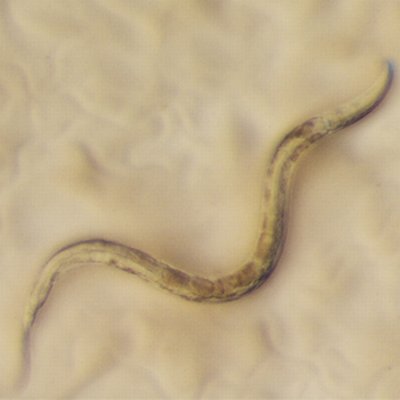Biologists’ favorite worm gets viruses
 Finding means C. elegans may aid studies of human infections
Finding means C. elegans may aid studies of human infections
Biologists’ favorite worm gets viruses
A workhorse of modern biology is sick, and scientists couldn’t be happier.
Researchers at Washington University School of Medicine in St. Louis, the Jacques Monod Institute in France and Cambridge University have found that the nematode C. elegans, a millimeter-long worm used extensively for decades to study many aspects of biology, gets naturally occurring viral infections.
The discovery means C. elegans is likely to help scientists study the way viruses and their hosts interact.
“We can easily disable any of C. elegans’ genes, confront the worm with a virus and watch to see if this makes the infection worse, better or has no effect,” says David Wang, PhD. “If it changes the worm’s response to infection, we will look to see if similar genes are present in humans and other mammals.”
Marie-Anne Felix, the Monod Institute

Scientists have discovered that C. elegans, a microscopic worm biologists have used in the lab to identify important biological phenomena, suffers from natural viral infections. This may mean that C. elegans can help scientists learn more about how hosts and viruses interact.
Wang, associate professor of pathology and immunology and of molecular microbiology at Washington University School of Medicine, says that several fundamental aspects of human biology, including the ability of cells to self-destruct to prevent cancer, and RNA interference, an important process for regulating how genes are used to make proteins, were first identified in C. elegans and later affirmed to be present in humans.
The findings appear online in PLoS Biology
Marie-Anne Felix, PhD, a researcher who studies nematodes at the Monod Institute, began the study by gathering C. elegans from rotting fruit in French orchards. Felix noted that some of her sample worms appeared to be sick. Treatment with antibiotics failed to cure them.
Felix then repeated a classic biology experiment that led to the discovery of viruses.
“She ground up the sick worms, passed them through a filter fine enough to remove any bacterial or parasitic infectious agents and exposed a new batch of worms to the ground-up remains of the first batch,” Wang says. “When the new batch got sick, she knew that a viral infection was likely to be present.”
Wang specializes in the identification of novel viruses. He found the worms had been suffering infections from two viruses related to nodaviruses, a class of viruses previously found to infect insects and fish. Nodaviruses are not currently known to infect humans. Tests showed one of the new viruses can infect the strain of C. elegans most commonly used in research.
“Model organisms are essential to important steps forward in biology, and we’re eager to see what C. elegans can teach us about the way hosts and viruses interact,” Wang says.
______________________________________________
* Felix M-A, Ashe A, Piffaretti J, Wu G, Nuez I, Belicard T, Jiang Y, Zhao G, Franz CJ, Goldstein LD, Sanroman M, Miska EA, Wang D. Natural and experimental infection of Caenorhabditis nematodes by novel viruses related to nodaviruses. PLoS: Biology, Jan. 25, 2011.
** Funding from French National Center for Scientific Research, the National Institutes of Health, the Midwest Regional Center for Excellence for Biodefense and Emerging Infectious Diseases Research, the Cancer Research UK Programme, the Burroughs-Wellcome Fund and the Herchel-Smith Foundation supported this research.
*** Washington University School of Medicine’s 2,100 employed and volunteer faculty physicians also are the medical staff of Barnes-Jewish and St. Louis Children’s hospitals. The School of Medicine is one of the leading medical research, teaching and patient care institutions in the nation, currently ranked fourth in the nation by U.S. News & World Report. Through its affiliations with Barnes-Jewish and St. Louis Children’s hospitals, the School of Medicine is linked to BJC HealthCare.
**** The above story is reprinted from materials provided by Washington University School of Medicine. The original article was written/posted By Michael C. Purdy



















